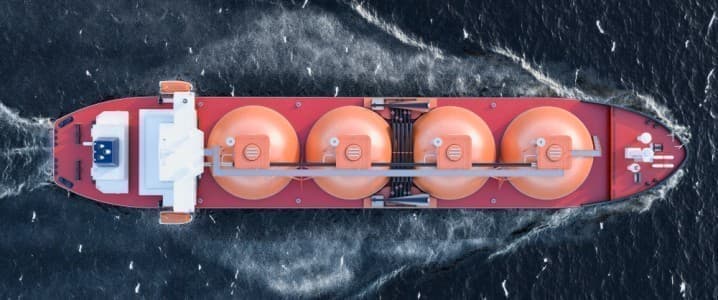Business
Global Floating LNG Capacity to Triple by 2030, Research Shows

Floating liquefied natural gas (FLNG) terminals are poised to revolutionize the global LNG market, with capacity projected to rise threefold by 2030. According to research from Rystad Energy, the global FLNG capacity will expand from 14.1 million tonnes per annum (Mtpa) in 2024 to 42 million Mtpa by 2030, and further to 55 Mtpa by 2035. This dramatic growth reflects a shift in the industry as FLNG projects overcome earlier technical and operational hurdles.
Recent data shows that FLNG terminals are achieving utilization rates that rival those of traditional onshore facilities. In 2024, terminals commissioned before that year recorded an average utilization rate of 86.5%, dropping slightly to 76% in 2025, figures comparable to global onshore LNG operations. The rising demand for LNG, coupled with the increasing feasibility of smaller gas fields, makes FLNG an attractive and adaptable solution, enabling access to previously stranded reserves.
The early days of FLNG were marked by challenges, particularly with projects like Shell’s Prelude, developed by the Technip–Samsung consortium. Prelude’s costs soared to $2,114 per tonne for liquefaction alone, highlighting the industry’s initial limitations. However, as companies gained experience, capital expenditures per tonne have significantly decreased, aligning more closely with those of onshore projects. Current proposals along the US Gulf Coast now average around $1,054 per tonne, with the Delfin FLNG project slightly above that at $1,134 per tonne, and Coral South FLNG in Mozambique reporting a similar cost of $1,062 per tonne.
Notably, FLNG developers are increasingly opting for vessel conversions as a cost-effective alternative to constructing new facilities. Projects like Tortue/Ahmeyim FLNG, Cameroon FLNG, and Southern Energy’s FLNG MK II have successfully repurposed existing Moss-type LNG carriers, achieving remarkably lower capital expenditures of $640, $500, and $630 per tonne, respectively. These conversions leverage the vessels’ modular spherical tank design, facilitating the integration of prefabricated liquefaction modules.
The operational flexibility of FLNG vessels across various environments—from deepwater to ultra-deepwater fields and even onshore supply—further enhances their appeal. Should a project face delays, the vessel can be relocated or sold, underscoring the inherent mobility and adaptability of FLNG assets. In the current energy landscape, characterized by tight markets and potential oversupply, rapid deployment is essential.
Extended construction timelines can delay revenue generation and increase the risk of cost overruns. Data from Rystad Energy indicates that FLNG units can be commissioned significantly faster than their onshore counterparts. On average, new FLNG projects take approximately three years to complete, compared to around 4.5 years for operational onshore plants. For FLNG vessels currently under construction, the average projected build time has further decreased to 2.85 years.
This expedited timeline is a critical factor in the growing preference for FLNG, as developers seek to minimize financial exposure while accelerating returns. The anticipated surge in FLNG capacity by 2030 reflects a transformative shift in the LNG market, with companies increasingly recognizing the advantages of flexibility and speed in a rapidly evolving energy sector.
-

 World4 months ago
World4 months agoSBI Announces QIP Floor Price at ₹811.05 Per Share
-

 Lifestyle4 months ago
Lifestyle4 months agoCept Unveils ₹3.1 Crore Urban Mobility Plan for Sustainable Growth
-

 Science4 months ago
Science4 months agoNew Blood Group Discovered in South Indian Woman at Rotary Centre
-

 World4 months ago
World4 months agoTorrential Rains Cause Flash Flooding in New York and New Jersey
-

 Sports4 months ago
Sports4 months agoBroad Advocates for Bowling Change Ahead of Final Test Against India
-

 Top Stories4 months ago
Top Stories4 months agoKonkani Cultural Organisation to Host Pearl Jubilee in Abu Dhabi
-

 Science4 months ago
Science4 months agoNothing Headphone 1 Review: A Bold Contender in Audio Design
-

 Top Stories4 months ago
Top Stories4 months agoAir India Crash Investigation Highlights Boeing Fuel Switch Concerns
-

 Sports4 months ago
Sports4 months agoCristian Totti Retires at 19: Pressure of Fame Takes Toll
-

 Business4 months ago
Business4 months agoIndian Stock Market Rebounds: Sensex and Nifty Rise After Four-Day Decline
-

 Politics4 months ago
Politics4 months agoAbandoned Doberman Finds New Home After Journey to Prague
-

 Top Stories4 months ago
Top Stories4 months agoPatna Bank Manager Abhishek Varun Found Dead in Well









